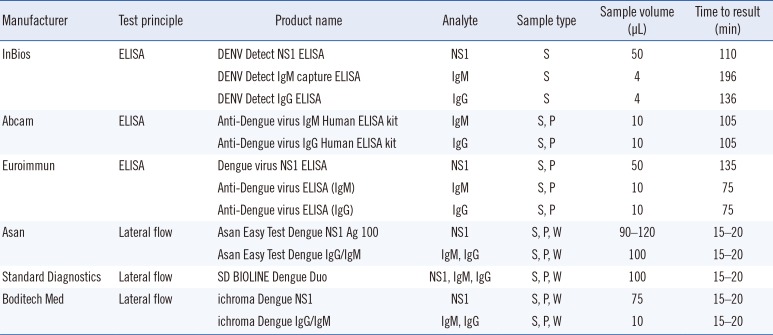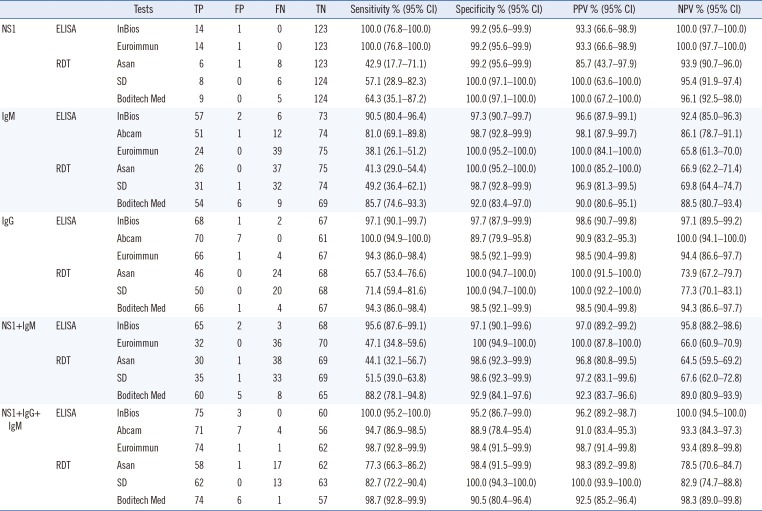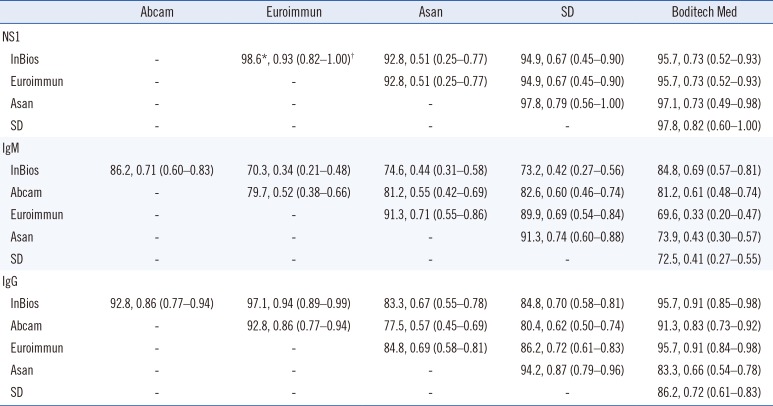Dengue virus (DENV) infection is a mosquito-borne disease that constitutes one of the major public health problems in subtropical and tropical areas [
12]. As many patients either have no symptoms or present with nonspecific fever requiring differential diagnosis, laboratory confirmation using a rapid, accurate, and relatively low-cost diagnostic test is especially important [
3]. Laboratory diagnosis for DENV infection includes detection of the virus, genome, non-structural (NS)-1 antigen or IgM/IgG antibodies, or a combination of these tests [
4]. NS1 is a highly conserved glycoprotein of flaviviruses that can be detected in blood samples, most often between one and nine days after the onset of symptoms, which is very efficient for early diagnosis of DENV infection [
5]. According to the WHO recommendations, confirmatory diagnosis of DENV infection includes virus detection by PCR or virus culture, detection of IgM seroconversion in paired sera, IgG seroconversion, or ≥four-fold increase in the IgG titer in paired sera [
1]. ELISA-based serological tests can detect IgM, IgG, or the NS1 glycoprotein [
6]. As many patients seek medical care five days after fever onset, anti-DENV IgM/IgG become suitable markers for diagnosing a recent DENV infection, and the anti-DENV IgG test can help differentiate primary and secondary DENV infections [
7]. In addition, rapid diagnostic tests (RDTs) are commonly used for DENV detection because of their simplicity and rapidity [
3]. Several ELISAs and RDTs are now widely available from different manufacturers. However, independent validation and comparative evaluation remain limited. Thus, we compared the performance of six commercial serological tests including three RDTs for diagnosing DENV infection. This study is the first to carry out such a comparison.
We tested a total of 138 single blood samples, including 34 samples from Korean patients suspected for DENV infection, 60 from patients with confirmed DENV infection (purchased from TRINA BIOREACTIVES AG, Nänikon, Switzerland), and 44 from healthy Korean subjects in a dengue non-endemic area. The supplier reported that the 60 samples were confirmed by clinical diagnosis and the DENV IgM test. Serum samples from Korean patients were sent to the laboratory of Seoul St. Mary's Hospital, Seoul, Korea, and stored at −80℃ until testing. The Institutional Review Board of Seoul St. Mary's Hospital approved this study (XC16SNMI0049K, KC17SNSI0246). Informed consent was waived because the current study was performed using leftover blood samples.
Evaluation was performed with three sets of ELISAs and three RDTs: (i) DENV Detect NS1 ELISA, DENV Detect IgM capture ELISA and DENV Detect IgG ELISA (InBios International, Inc., Seattle, WA, USA); (ii) Anti-Dengue virus IgM Human ELISA and Anti-Dengue virus IgG Human ELISA (Abcam, Cambridge, MA, USA); (iii) Dengue virus NS1 ELISA, Anti-Dengue virus ELISA (IgM) and Anti-Dengue virus ELISA (IgG) (Euroimmun, Lübeck, Germany); (iv) Asan Easy Test Dengue NS1 Ag 100 and Asan Easy Test Dengue IgG/IgM (Asan Pharm, Seoul, Korea); (v) SD BIOLINE Dengue Duo (Standard Diagnostics Inc., Seoul, Korea); and (vi) Ichroma Dengue NS1 and Ichroma Dengue IgG/IgM (Boditech Med, Chuncheon, Korea). All six tests can detect all three targets (NS1 antigen, DENV IgM antibody, and DENV IgG antibody) except for Abcam ELISA, which can detect only the anti-DENV IgM and IgG antibodies. All tests were performed according to the manufacturers' instructions. We performed the tests only once and repeated the tests when there was an invalid result, according to the manufacturers' instructions. The test characteristics are summarized in
Table 1. For the NS1 antigen and DENV IgM/IgG tests, cross-reactivity was tested using samples from patients with confirmed chikungunya infection (N=20) (TRINA BIOREACTIVES AG). To detect cross-reactivity with other viral infections, serum from patients with positive IgG against Epstein–Barr virus (N=10), cytomegalovirus (N=10), hepatitis A virus (N=10), hepatitis B virus (N=10), family
Flaviviridae hepatitis C virus (N=10), and rubella (N=10) were tested using these six tests.
Table 1
Characteristics of six commercial tests for diagnosing DENV infection

|
Manufacturer |
Test principle |
Product name |
Analyte |
Sample type |
Sample volume (µL) |
Time to result (min) |
|
InBios |
ELISA |
DENV Detect NS1 ELISA |
NS1 |
S |
50 |
110 |
|
DENV Detect IgM capture ELISA |
IgM |
S |
4 |
196 |
|
DENV Detect IgG ELISA |
IgG |
S |
4 |
136 |
|
Abcam |
ELISA |
Anti-Dengue virus IgM Human ELISA kit |
IgM |
S, P |
10 |
105 |
|
Anti-Dengue virus IgG Human ELISA kit |
IgG |
S, P |
10 |
105 |
|
Euroimmun |
ELISA |
Dengue virus NS1 ELISA |
NS1 |
S, P |
50 |
135 |
|
Anti-Dengue virus ELISA (IgM) |
IgM |
S, P |
10 |
75 |
|
Anti-Dengue virus ELISA (IgG) |
IgG |
S, P |
10 |
75 |
|
Asan |
Lateral flow |
Asan Easy Test Dengue NS1 Ag 100 |
NS1 |
S, P, W |
90–120 |
15–20 |
|
Asan Easy Test Dengue IgG/IgM |
IgM, IgG |
S, P, W |
100 |
15–20 |
|
Standard Diagnostics |
Lateral flow |
SD BIOLINE Dengue Duo |
NS1, IgM, IgG |
S, P, W |
100 |
15–20 |
|
Boditech Med |
Lateral flow |
ichroma Dengue NS1 |
NS1 |
S, P, W |
75 |
15–20 |
|
ichroma Dengue IgG/IgM |
IgM, IgG |
S, P, W |
10 |
15–20 |

For each NS1 antigen, DENV IgM, and DENV IgG test, reference positive results were defined when the samples were positive using two or more of the ELISAs examined. All samples that were not classified as reference positives were considered as reference DENV negative samples. The reference results for NS1 antigen, IgM, IgG, and PCR of all clinical samples are provided in
Supplemental Data Table S1.
Statistical analyses were performed using MedCalc version 15.5 (MedCalc, Ostend, Belgium). Diagnostic accuracy, agreement rates, and Cohen's kappa coefficients (κ) between tests were calculated, as well as sensitivity, specificity, positive predictive value (PPV) and negative predictive value (NPV) for each test. The κ values were shown with 95% confidence interval and were interpreted as very good (0.81–1.00), good (0.61–0.80), moderate (0.41–0.60), fair (0.21–0.40), or poor (<0.20). Pearson's correlation coefficient was calculated between optical density (OD) values of Euroimmun with the other tests.
For NS1 antigen detection, the InBios and Euroimmun ELISAs showed 100% sensitivity and 99.2% specificity. The three RDTs (Asan, SD, and Boditech Med) showed high specificity (99.2–100.0%), PPV (85.7–100%) and NPV (93.9–96.1%). However, the sensitivities of these RDTs were low (42.9–64.3%;
Table 2). Previous studies have reported a wide range of performances (sensitivity: 18.6–96.9%; specificity: 53–100%) [
89].
Table 2
Performance of six commercial tests for detecting NS1 antigen and anti-dengue IgM and IgG antibodies

|
Tests |
TP |
FP |
FN |
TN |
Sensitivity % (95% CI) |
Specificity % (95% CI) |
PPV % (95% CI) |
NPV % (95% CI) |
|
NS1 |
ELISA |
InBios |
14 |
1 |
0 |
123 |
100.0 (76.8–100.0) |
99.2 (95.6–99.9) |
93.3 (66.6–98.9) |
100.0 (97.7–100.0) |
|
Euroimmun |
14 |
1 |
0 |
123 |
100.0 (76.8–100.0) |
99.2 (95.6–99.9) |
93.3 (66.6–98.9) |
100.0 (97.7–100.0) |
|
RDT |
Asan |
6 |
1 |
8 |
123 |
42.9 (17.7–71.1) |
99.2 (95.6–99.9) |
85.7 (43.7–97.9) |
93.9 (90.7–96.0) |
|
SD |
8 |
0 |
6 |
124 |
57.1 (28.9–82.3) |
100.0 (97.1–100.0) |
100.0 (63.6–100.0) |
95.4 (91.9–97.4) |
|
Boditech Med |
9 |
0 |
5 |
124 |
64.3 (35.1–87.2) |
100.0 (97.1–100.0) |
100.0 (67.2–100.0) |
96.1 (92.5–98.0) |
|
IgM |
ELISA |
InBios |
57 |
2 |
6 |
73 |
90.5 (80.4–96.4) |
97.3 (90.7–99.7) |
96.6 (87.9–99.1) |
92.4 (85.0–96.3) |
|
Abcam |
51 |
1 |
12 |
74 |
81.0 (69.1–89.8) |
98.7 (92.8–99.9) |
98.1 (87.9–99.7) |
86.1 (78.7–91.1) |
|
Euroimmun |
24 |
0 |
39 |
75 |
38.1 (26.1–51.2) |
100.0 (95.2–100.0) |
100.0 (84.1–100.0) |
65.8 (61.3–70.0) |
|
RDT |
Asan |
26 |
0 |
37 |
75 |
41.3 (29.0–54.4) |
100.0 (95.2–100.0) |
100.0 (85.2–100.0) |
66.9 (62.2–71.4) |
|
SD |
31 |
1 |
32 |
74 |
49.2 (36.4–62.1) |
98.7 (92.8–99.9) |
96.9 (81.3–99.5) |
69.8 (64.4–74.7) |
|
Boditech Med |
54 |
6 |
9 |
69 |
85.7 (74.6–93.3) |
92.0 (83.4–97.0) |
90.0 (80.6–95.1) |
88.5 (80.7–93.4) |
|
IgG |
ELISA |
InBios |
68 |
1 |
2 |
67 |
97.1 (90.1–99.7) |
97.7 (87.9–99.9) |
98.6 (90.7–99.8) |
97.1 (89.5–99.2) |
|
Abcam |
70 |
7 |
0 |
61 |
100.0 (94.9–100.0) |
89.7 (79.9–95.8) |
90.9 (83.2–95.3) |
100.0 (94.1–100.0) |
|
Euroimmun |
66 |
1 |
4 |
67 |
94.3 (86.0–98.4) |
98.5 (92.1–99.9) |
98.5 (90.4–99.8) |
94.4 (86.6–97.7) |
|
RDT |
Asan |
46 |
0 |
24 |
68 |
65.7 (53.4–76.6) |
100.0 (94.7–100.0) |
100.0 (91.5–100.0) |
73.9 (67.2–79.7) |
|
SD |
50 |
0 |
20 |
68 |
71.4 (59.4–81.6) |
100.0 (94.7–100.0) |
100.0 (92.2–100.0) |
77.3 (70.1–83.1) |
|
Boditech Med |
66 |
1 |
4 |
67 |
94.3 (86.0–98.4) |
98.5 (92.1–99.9) |
98.5 (90.4–99.8) |
94.3 (86.6–97.7) |
|
NS1+IgM |
ELISA |
InBios |
65 |
2 |
3 |
68 |
95.6 (87.6–99.1) |
97.1 (90.1–99.6) |
97.0 (89.2–99.2) |
95.8 (88.2–98.6) |
|
Euroimmun |
32 |
0 |
36 |
70 |
47.1 (34.8–59.6) |
100 (94.9–100.0) |
100.0 (87.8–100.0) |
66.0 (60.9–70.9) |
|
RDT |
Asan |
30 |
1 |
38 |
69 |
44.1 (32.1–56.7) |
98.6 (92.3–99.9) |
96.8 (80.8–99.5) |
64.5 (59.5–69.2) |
|
SD |
35 |
1 |
33 |
69 |
51.5 (39.0–63.8) |
98.6 (92.3–99.9) |
97.2 (83.1–99.6) |
67.6 (62.0–72.8) |
|
Boditech Med |
60 |
5 |
8 |
65 |
88.2 (78.1–94.8) |
92.9 (84.1–97.6) |
92.3 (83.7–96.6) |
89.0 (80.9–93.9) |
|
NS1+IgG+ IgM |
ELISA |
InBios |
75 |
3 |
0 |
60 |
100.0 (95.2–100.0) |
95.2 (86.7–99.0) |
96.2 (89.2–98.7) |
100.0 (94.5–100.0) |
|
Abcam |
71 |
7 |
4 |
56 |
94.7 (86.9–98.5) |
88.9 (78.4–95.4) |
91.0 (83.4–95.3) |
93.3 (84.3–97.3) |
|
Euroimmun |
74 |
1 |
1 |
62 |
98.7 (92.8–99.9) |
98.4 (91.5–99.9) |
98.7 (91.4–99.8) |
93.4 (89.8–99.8) |
|
RDT |
Asan |
58 |
1 |
17 |
62 |
77.3 (66.3–86.2) |
98.4 (91.5–99.9) |
98.3 (89.2–99.8) |
78.5 (70.6–84.7) |
|
SD |
62 |
0 |
13 |
63 |
82.7 (72.2–90.4) |
100.0 (94.3–100.0) |
100.0 (93.9–100.0) |
82.9 (74.7–88.8) |
|
Boditech Med |
74 |
6 |
1 |
57 |
98.7 (92.8–99.9) |
90.5 (80.4–96.4) |
92.5 (85.2–96.4) |
98.3 (89.0–99.8) |

For DENV IgM detection, the six tests showed variable sensitivities (38.1–90.5%). Two ELISAs (InBios and Abcam) and one RDT (Boditech Med) had higher sensitivities (81.0–90.5%) than the other three tests (Euroimmun, Asan, and SD; 38.1–49.2%). When we evaluated the combined NS1 antigen and DENV IgM antibody results for each test, five of the six tests (except Abcam) showed variable sensitivity (44.1–95.6%) and NPV (64.5–95.8%). However, they showed high specificity (92.9–100%) and high PPV (92.3–100%). Of these, InBios ELISA showed a sensitivity of 95.6% and a specificity of 97.1% for NS1+IgM results, while Euroimmun, Asan, and SD ELISAs showed lower sensitivity. When the NS1+IgM+IgG results were combined, the diagnostic accuracy of all the RDTs improved.
The sensitivity of DENV IgM antibodies is lower for secondary infections than for primary infections, and the DENV IgM antibody alone does not provide sufficient results for DENV diagnosis [
710]. Therefore, a combination of NS1 and IgM antibody tests is recommended [
8]. When we combined the NS1 antigen and IgM antibody results, the RDTs and ELISAs had similar performance, confirming previous reports that RDTs could be useful in clinical settings [
3111213]. In our study, the sensitivity of the Euroimmun ELISA for IgM detection was as low as 38.1%. However, the correlations between OD values measured by Euroimmun and those by the other two ELISAs were strong (Abcam: r=0.94,
P<0.001; InBios: r=0.84,
P<0.001). Therefore, it seems necessary to verify the cut-off value of Euroimmun ELISA. As the IgM titer might be very low or undetectable in some secondary DENV infections [
1], negative IgM results should not rule out the possibility of DENV infection.
For IgG antibody detection, all three ELISAs and one RDT (Boditech Med) showed sensitivities >94.0%. Previous studies have reported variable sensitivities for DENV IgG and IgM ELISAs (7.8–88.9% and 20.2–99%, respectively) with various specificities (63.5–100% and 52–100%, respectively) [
49]. However, the RDTs showed relatively low NPVs (73.9–94.3%) than the ELISAs (94.4–100.0%).
In the evaluation of agreement, the InBios and Euroimmun ELISAs showed a 98.6% agreement rate for NS1 antigen detection (κ=0.93) (
Table 3). The three RDTs also showed a high agreement rate of 97.1–97.8% for NS1 detection (κ=0.73–0.82). Although we evaluated NS1 antigen tests based on reference serology instead of clinical diagnosis, the agreements between tests were good, suggesting that NS1 antigen tests could support diagnostic tests for acute DENV infection. For DENV IgM detection, the InBios and Abcam ELISA results showed good agreement (86.2%, κ=0.71), while Euroimmun ELISA showed fair (70.3%, κ=0.34) and moderate (79.7%, κ=0.52) agreement with the InBios and Abcam IgM tests, respectively. When agreements between RDT and ELISA DENV IgM tests were compared, the Boditech Med IgM test results showed good agreement with InBios (84.8%, κ=0.69) or Abcam (81.2%, κ=0.61). These six tests for DENV IgG antibody demonstrated very good to good agreement (80.4–97.1%, κ>0.60) except between Abcam ELISA IgG and the Asan RDT IgG test (77.5%, κ=0.57).
Table 3
Agreement between the dengue virus NS1 antigen and IgM/IgG antibody detection results of available tests

|
Abcam |
Euroimmun |
Asan |
SD |
Boditech Med |
|
NS1 |
|
|
|
|
|
|
InBios |
- |
98.6*, 0.93 (0.82–1.00)†
|
92.8, 0.51 (0.25–0.77) |
94.9, 0.67 (0.45–0.90) |
95.7, 0.73 (0.52–0.93) |
|
Euroimmun |
- |
- |
92.8, 0.51 (0.25–0.77) |
94.9, 0.67 (0.45–0.90) |
95.7, 0.73 (0.52–0.93) |
|
Asan |
- |
- |
- |
97.8, 0.79 (0.56–1.00) |
97.1, 0.73 (0.49–0.98) |
|
SD |
- |
- |
- |
- |
97.8, 0.82 (0.60–1.00) |
|
IgM |
|
|
|
|
|
|
InBios |
86.2, 0.71 (0.60–0.83) |
70.3, 0.34 (0.21–0.48) |
74.6, 0.44 (0.31–0.58) |
73.2, 0.42 (0.27–0.56) |
84.8, 0.69 (0.57–0.81) |
|
Abcam |
- |
79.7, 0.52 (0.38–0.66) |
81.2, 0.55 (0.42–0.69) |
82.6, 0.60 (0.46–0.74) |
81.2, 0.61 (0.48–0.74) |
|
Euroimmun |
- |
- |
91.3, 0.71 (0.55–0.86) |
89.9, 0.69 (0.54–0.84) |
69.6, 0.33 (0.20–0.47) |
|
Asan |
- |
- |
- |
91.3, 0.74 (0.60–0.88) |
73.9, 0.43 (0.30–0.57) |
|
SD |
- |
- |
- |
- |
72.5, 0.41 (0.27–0.55) |
|
IgG |
|
|
|
|
|
|
InBios |
92.8, 0.86 (0.77–0.94) |
97.1, 0.94 (0.89–0.99) |
83.3, 0.67 (0.55–0.78) |
84.8, 0.70 (0.58–0.81) |
95.7, 0.91 (0.85–0.98) |
|
Abcam |
- |
92.8, 0.86 (0.77–0.94) |
77.5, 0.57 (0.45–0.69) |
80.4, 0.62 (0.50–0.74) |
91.3, 0.83 (0.73–0.92) |
|
Euroimmun |
- |
- |
84.8, 0.69 (0.58–0.81) |
86.2, 0.72 (0.61–0.83) |
95.7, 0.91 (0.84–0.98) |
|
Asan |
- |
- |
- |
94.2, 0.87 (0.79–0.96) |
83.3, 0.66 (0.54–0.78) |
|
SD |
- |
- |
- |
- |
86.2, 0.72 (0.61–0.83) |

When cross-reactivity was tested using samples from patients with confirmed infection with chikungunya virus and hepatitis C virus, none of the five DENV NS1 antigen tests showed positivity. However, all six DENV IgG tests demonstrated variable potential cross-reactivity (range, 30–90%) with chikungunya IgG (
Supplemental Data Fig. S1). High intra-genus cross-reactivity with
Flavivirus is due to common antigenic determinants in patients with previous
Flavivirus infection or vaccination [
14]. Positive results due to non-dengue
Flavivirus infection should always be considered in endemic areas. Serological results can be useful in diagnosing DENV infection in conjunction with medical history, symptoms, and epidemiological information [
15]. In our study, the six tests for DENV IgG detection showed variable positivity with chikungunya. However, we could not rule out coinfection with chikungunya and could not determine whether the patients were in the acute or recovery phase. Confirmation of DENV infection by PCR would constitute a good practice in NS1-positive patients to resolve the problem of cross-reactivity, particularity in highly endemic regions [
9].
This study had some limitations. We could not evaluate the results by DENV serotype or primary/secondary infection status and could not test cross-reactivation with other common Flavivirus infections, such as Japanese encephalitis, zika virus infection, and yellow fever, because of resource constraints. In addition, we used single samples, which could not demonstrate dengue seroconversion, and the total number of NS1-positive samples was relatively small. Larger studies would be helpful to sufficiently compare the performance of the DENV diagnostic tests.
Over the years, immunoassays have progressed dramatically from manual to automated bench systems. However, simple manual immunoassays or point-of-care tests are still desirable in regions with insufficient laboratory resources and expertise [
16]. The global spread of DENV and the growing number of international travelers have necessitated that attention be paid to DENV infection in non-endemic areas, including Korea [
17].
In conclusion, the ELISAs demonstrated good performance for diagnosing DENV infection, and the RDTs showed reliable results compared with ELISA. However, clinical laboratories should be aware of performance variations across tests and the possibilities of cross-reactivity.







 PDF
PDF ePub
ePub Citation
Citation Print
Print



 XML Download
XML Download